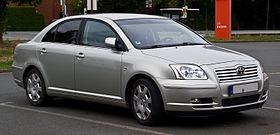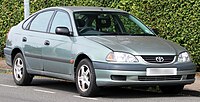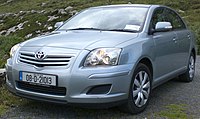Toyota Avensis
| Toyota Avensis | |
|---|---|
 2009 Toyota Avensis saloon (T270) | |
| Overview | |
| Manufacturer | Toyota |
| Production | October 1997 – August 2018 |
| Assembly | United Kingdom: Burnaston, Derbyshire (Toyota Manufacturing UK) |
| Body and chassis | |
| Class | Mid-size/large family car (D) |
| Layout | |
| Chronology | |
| Predecessor |
|
| Successor | Toyota Camry (XV70) |
The Toyota Avensis (Japanese: トヨタ・アベンシス, Hepburn: Toyota Abenshisu) is a mid-size/large family car built in Derbyshire, United Kingdom by the Japanese automaker Toyota from October 1997 to August 2018. It was the direct successor to the European Carina E and was available as a four-door saloon, five-door liftback and estate.
The Avensis was introduced in 1997, to create a more modern name when compared with the Carina E. The "Avensis" name is derived from the French term avancer, meaning "to advance" or "move forward".[1] The Avensis was not sold in North America, and it is related to the Scion tC coupé. It also shared a platform with the Allion and Premio and was available at Japanese dealership network Toyota Netz Store.
An MPV called the Avensis Verso (Ipsum in Japan and previously the Picnic in other markets) was built in Japan on a separate platform.
First generation (T220; 1997)
[edit]| First generation | |
|---|---|
 Toyota Avensis GS (UK) | |
| Overview | |
| Model code | T220 |
| Also called |
|
| Production | 1997–2003 |
| Body and chassis | |
| Body style | |
| Related | |
| Powertrain | |
| Engine | |
| Transmission |
|
| Dimensions | |
| Wheelbase | 2,630 mm (103.5 in) |
| Length |
|
| Width | 1,710 mm (67.3 in) |
| Height |
|
Toyota introduced the Avensis nameplate on its new model, which was launched at the end of 1997. The car was actually an extensive facelift of the previous generation Carina E, with the platform and engines carried over, and a restyled body. The car was built at the Burnaston factory in Derby. At the same time, production of the five-door Toyota Corolla also started at the British plant.
The first generation Avensis had the option of four engines (1.6-, 1.8- and 2.0-litre petrol and a 2.0-litre turbo-diesel) and three body styles (saloon, hatchback and estate). The station wagon was essentially the Japanese-market second generation Toyota Caldina. All of the range gave solid build quality, excellent reliability, a spacious comfortable interior, generous equipment, smooth ride quality and good refinement, but very little in the way of excitement.
The model received a facelift in August 2000. The engines were fitted with variable valve timing, satellite navigation was included as a standard feature along the range and the sporty Avensis 2.0 L SR (with body kit and tuned suspension) was added but overall sales remained low.
The Avensis was also sold in South America. In Argentina and Brazil, it was sold as the Toyota Corona (as seen on brochures), but in Chile and Peru, it was sold as the Corona Avensis. In Greece, the Toyota Corona model name had long been synonymous with "taxi", so Avensis' sold for taxi use received "Toyota Corona" badging until the 2000 facelift.[2] Models for private use and post-facelift taxis were Avensis, just like in the rest of Europe.
-
Liftback (pre-facelift)
-
Saloon (pre-facelift)
-
Estate (pre-facelift)
-
Liftback (facelift)
-
Liftback (facelift)
-
Saloon (facelift)
-
Estate (facelift)
Engines
[edit]Petrol
[edit]- 1.6-litre 4A-FE 81 kW (110 hp)
- 1.6-litre VVT-i 3ZZ-FE 81 kW (110 hp)
- 1.8-litre 7A-FE 81 kW (110 hp)
- 1.8-litre VVT-i 1ZZ-FE 95 kW (129 hp)
- 2.0-litre 3S-FE 94 kW (128 hp)
- 2.0-litre D4 VVT-i 1AZ-FSE 110 kW (150 hp)
Diesel
[edit]Second generation (T250; 2003)
[edit]| Second generation | |
|---|---|
 Toyota Avensis (Germany) | |
| Overview | |
| Model code | T250 |
| Production | January 2003 – 2009 |
| Body and chassis | |
| Body style | |
| Platform | Toyota MC platform |
| Related | |
| Powertrain | |
| Engine | |
| Transmission |
|
| Dimensions | |
| Wheelbase | 2,700 mm (106.3 in) |
| Length |
|
| Width | 1,760 mm (69.3 in) |
| Height |
|
| Chronology | |
| Predecessor |
|
The second generation Avensis was launched in February 2003, in an all new format; this time it offered more in the way of driver involvement and visual appeal. It was launched in Japan in saloon and estate form in October 2003, replacing the V50 series Vista and Vista Ardeo. Like the Echo/Yaris and Corolla, it was penned by the company's design studio in France.[3] Production officially began on 6 January 2003. Following the withdrawal of the Camry in 2004 (2005 in Switzerland), the Avensis became the largest Toyota saloon sold in Western Europe.
Trim levels in the United Kingdom were T2, T3-S, T3-X, T4, T Spirit, T180 and TR. There is also a special edition, based on the T2 called the Colour Collection. In Ireland, there were five trim levels – Terra, Aura, Strata, Luna and Sol. In Japan, the Avensis is sold as 2.0 Xi, 2.0 Li (later replaced by 2.4 Li) and 2.4 Qi. Only the base model 2.0 Xi is offered with four-wheel drive.
This is first and only generation of Avensis sold in Egypt and Morocco, not in Persian Gulf countries.[citation needed]
In the 2004 European Car of the Year contest, the Avensis came in fourth place behind the Fiat Panda (winner), Mazda3 (second) and the Volkswagen Golf (third). However, it won the 2004 Semperit Irish Car of the Year. What Car? also awarded the Avensis as the "Best Family Car" for 2004 and 2005.
-
Liftback (pre-facelift)
-
Saloon (pre-facelift)
-
Estate (pre-facelift)
-
Interior
Facelift
[edit]In 2006, the Avensis received a mid-career facelift. Exterior cosmetic changes include a slightly redesigned logo, a new front grille with double concave lines (including a new darker grille treatment on higher trim levels), new headlamps and rear combination lamps, revised front bumpers and front fog lights, door mirror with turn signals adoption, new tyres, a new wheel design (in two colours) and a new wheel cap design, and five changed body colours.[4] Toyota describes the cosmetic changes as strengthening the family connection with the Corolla and Yaris, and allowing the Avensis to maintain a premium look while giving it a sportier appearance.[4]
Inside, the dashboard materials are revised, the beige interior is replaced by a new grege interior, the instrumentation is revised, the design of the switches is changed, the passenger seat is now height adjustable, alcantara seats are available, and the seats become 60:40 split folding.[4] The Hi-Fi, which previously had a CD and tape player, now only accepts CDs but also plays MP3s.[4] The central screen containing the information of the on-board computer has been removed in favour of a compartment (as on the previous entry-level) and is now integrated into the meters facing the driver.
From a structural point of view, the underbody is reinforced.[4] Finally, the 2.0L D4D 85 kW (115 hp) diesel engine is replaced by the 2.0L D4D 93 kW (126 hp) engine.[4] This, coupled to a six-speed manual gearbox, has lowered fuel consumption, emissions, and gives a quoted 0–97 km/h (0–60 mph) time of 10.5 seconds.
-
Saloon (facelift)
-
Saloon (facelift)
-
Estate (Japan; facelift)
-
Estate (Japan; facelift)
Safety
[edit]In 2003, the Avensis became the first Japanese vehicle to receive a five-star rating under the Euro NCAP's redone testing, with 34 total points it also became the highest rated vehicle they had tested.[5] In 2003, the Avensis also became the first vehicle sold in Europe with a knee airbag.[6]
Engines
[edit]The 1.6-, 1.8- and 2.0-litre petrol and 2.0-litre turbo-diesel engines were carried over from the previous Avensis, and the 2.4-litre four-cylinder from the Camry was also added to the range. This was the first Avensis to be exported to Japan. Due to the Camry Wagon ending production, the Avensis Wagon is exported to New Zealand, in both 1.8- and 2.0-litre forms. In the United Kingdom, there were no 1.6-litre versions available.
The original 115 PS (85 kW) D-4D diesel engine has been complemented with a 2.2 L D-4D in 136 PS (2AD-FTV) and 177 PS (2AD-FHV) versions. Newer versions have dropped the "D-4D" and "2.0" badging from the front wings and tailgate respectively.
From 2005, the 2.4 L version was fitted with a 5-speed automatic transmission.
Petrol
[edit]- 1.6-litre VVT-i 3ZZ-FE 81 kW (110 hp)
- 1.8-litre VVT-i 1ZZ-FE 95 kW (129 hp)
- 2.0-litre VVT-i 1AZ-FSE 108 kW (147 hp)
- 2.4-litre VVT-i 2AZ-FSE 120 kW (163 hp)
Diesel
[edit]- 2.0-litre D-4D 1CD-FTV 85 kW (115 hp)
- 2.0-litre D-4D 1AD-FTV 93 kW (126 hp)
- 2.2-litre D-4D 2AD-FTV 110 kW (150 hp)
- 2.2-litre D-Cat 2AD-FHV 130 kW (177 hp)
Third generation (T270; 2009)
[edit]| Third generation | |
|---|---|
 Pre-facelift Toyota Avensis wagon (Netherlands) | |
| Overview | |
| Model code | T270 |
| Production | January 2009 – August 2018 |
| Body and chassis | |
| Body style | |
| Platform | Toyota New MC platform |
| Related | |
| Powertrain | |
| Engine | |
| Transmission |
|
| Dimensions | |
| Wheelbase | 2,700 mm (106.3 in) |
| Length |
|
| Width | 1,810 mm (71.3 in) |
| Height | 1,480 mm (58.3 in)[7][8] |
| Chronology | |
| Predecessor | Toyota Caldina (T240) (Japan, for wagon/estate models) |
| Successor | Toyota Camry (XV70) |
The third generation Avensis was revealed at the 2008 Paris Motor Show. It went on sale in January 2009. Like the previous model, it is built at Toyota's Burnaston plant in Derbyshire, England. This generation is available in saloon or estate styles only.[9] The third generation Avensis full-year sales goal was of 115,000 vehicles.[10]
Toyota ED2 initially designed the Avensis giving it a more sleek and athletic stance. It has a drag coefficient of Cd=0.28 for the saloon and Cd=0.29 for the wagon body. Other design goals were to create the most comfortable suspension in its class while still offering sporty handling. The Avensis continued to use front MacPherson struts and rear double wishbones. Unlike the previous generation Avensis models, there is no five door hatchback body style in this lineup, in favour of saloon and estate body styles.
Major options include bi xenon HID headlamps, Adaptive Front-lighting System (AFS), and adaptive cruise control.
The Avensis wagon began being imported again to Japan in mid-2011, with 2.0-litre 4-cylinder engine and CVT transmission in Li and Xi variants.[11] The Avensis wagon was discontinued in Japan on 27 April 2018.[citation needed]
-
Saloon (pre-facelift)
-
Estate (pre-facelift)
First facelift (2012–2015)
[edit]The Avensis underwent a facelift in January 2012. This included a revised front grille and modified tail lamps. The changes were first shown in September 2011 at the Frankfurt Motor Show[12] before sales started in January 2012.[13]
-
Estate (first facelift)
-
Estate (first facelift)
Second facelift (2015–2018)
[edit]A further facelift was shown in March 2015 at the Geneva Motor Show.[14] The facelifted vehicle was officially launched in June 2015. This included a revised front grille, rear view, headlamps and taillamps and a new interior. In addition to the new "Toyota Safety Sense", new engines were also shown. The 1.6-litre diesel replaces the previous 2.0-litre engine.
-
Saloon (second facelift)
-
Saloon (second facelift)
-
Estate (second facelift)
-
Estate (second facelift)
Safety
[edit]For safety, seven airbags are standard, including two front row side torso airbags, two side curtain airbags for both rows, and a driver's knee airbag. For rear collisions, active front headrests designed to help reduce whiplash are standard as well as brake lamps that flash under emergency braking. Vehicle Stability Control+ (VSC+) applies torque to the steering wheel to aid the driver in steering. A Pre-Collision System (PCS) becomes optional which includes Lane Departure Warning (LDW) and Lane Keeping Assist (LKA).
The Avensis received a five-star rating under the latest Euro NCAP ratings scheme with an 81% overall score and a 90% score for adult occupant safety.[15]
Engines
[edit]The Avensis offers three petrol and four diesel engine options. Petrol engines are sourced from Toyota's Deeside Engine Plant.[16] The new engines feature more power and lower CO2 emissions. The new ZR engines became the first to introduce Toyota's Valvematic technology.
Petrol
[edit]- 1.6-litre 1ZR-FAE 97 kW (130 hp) 2008–2018
- 1.8-litre 2ZR-FAE 108 kW (145 hp) 2008–2018
- 2.0-litre 3ZR-FAE 112 kW (150 hp) 2008–2018, 2008–2011 (Germany)
Diesel
[edit]- 1.6-litre D-4D 1WW 82 kW (110 hp) 2015–2017[17]
- 2.0-litre D-4D 1AD-FTV 91 kW (122 hp) 2011–2015
- 2.0-litre D-4D 1AD-FTV 93 kW (125 hp) 2008–2011
- 2.0-litre D-4D 2WW 105 kW (141 hp) 2015–2018[17]
- 2.2-litre D-4D 2AD-FTV 110 kW (148 hp) 2008–2015
- 2.2-litre D-4D 2AD-FHV 130 kW (174 hp) 2008–2015
All engines are mated to a six-speed manual transmission while the 1.8 L and 2.0 L petrol engines are available with a Multidrive S CVT transmission. The 2.2-litre D-4D 150 hp engine is available with a six-speed automatic transmission.
Motorsports
[edit]
On 2 August 2010, it was announced the British Touring Car Championship's NGTC prototype car would be built around the Toyota Avensis.[18]
Series organiser TOCA, which would fully introduce the new low-cost NGTC technical regulations in 2011, said that the Japanese manufacturer would supply a donor car and a new body shell to the programme. The Avensis was used by Speedworks Motorsport, driven by Tom Ingram, until the end of the 2018 season.[19]
Discontinuation
[edit]The Avensis was discontinued in the United Kingdom in August 2018 and across Europe in late 2018. It was partially replaced by the slightly larger XV70 series Camry, which is based on the TNGA-K platform.[20]
Nameplate usage for other models
[edit]
Avensis Verso
[edit]The Avensis Verso was a large MPV introduced in 2001 using the Avensis nameplate, with room for seven occupants and only initially available with 2.0-litre engines. The Avensis Verso's platform preceded the second generation model. The Avensis Verso was the back-to-back winner of Australia's Best People Mover award in 2002 and 2003.[21] The Avensis Verso continued to be available alongside the second-generation Avensis until 2006.
See also
[edit]References
[edit]- ^ "Data: Origin of a car's name". Toyota. 2012. Retrieved 14 February 2015.
- ^ "Γιατί τα παλιά ταξί Toyota λέγονται Corona" [Why old Toyota taxis are called Corona]. AutoGreekNews (in Greek). 22 August 2020. Archived from the original on 31 July 2021.
- ^ "2009 European styling helps Avensis deliver". Retrieved 23 February 2009.
- ^ a b c d e f Avensis Product Marketing Guide Product Detail 1st Edition (PDF). Toyota Motor Corporation Overseas Marketing Division. 27 December 2005.
- ^ "The new Toyota Avensis: the safest car in its class according to Euro NCAP" (Press release). Europe: Toyota. Archived from the original on 6 January 2009.
- ^ "Airbags". Europe: Toyota. Archived from the original on 18 December 2007.
- ^ Toyota Avensis Saloon (09 on) Dimensions – Facts and Figures | Parkers
- ^ Toyota Avensis Tourer (09 on) Dimensions – Facts and Figures | Parkers
- ^ "All-new Avensis for Paris". Daily news. New Car Net. 1 September 2008. Archived from the original on 25 January 2009. Retrieved 7 September 2008.
- ^ "Europe influenced Toyota's new Avensis". Automotive News Europe. 3 October 2008. Retrieved 23 April 2022.
- ^ "Toyota Avensis Wagon (Japan)". Archived from the original on 27 June 2011.
- ^ "Toyota Avensis Facelift Presented at Frankurt Motorshow". Full Speed Wheels. 15 September 2011. Archived from the original on 8 December 2015. Retrieved 27 November 2015.
- ^ "Toyota Avensis Facelift: Die Preise ab 2012" [Toyota Avensis Facelift: Prices for 2012]. Auto Zeitung (in German). 8 November 2011. Retrieved 27 November 2015.
- ^ "Toyota bringing updated Avensis to Geneva". Autoblog. 17 February 2015. Retrieved 20 April 2016.
- ^ Toyota Avensis | Euro NCAP – For safer cars crash test safety rating
- ^ "New Toyota Avensis – in production and available to order now" (Press release). UK: Toyota. Retrieved 11 February 2015.
- ^ a b "New Toyota Avensis: UK Range, Specifications And Prices Announced" (Press release). UK: Toyota. 2 April 2015. Retrieved 25 September 2018.
- ^ O'Leary, Jamie (2 August 2010). "Avensis to be NGTC base car". Auto Sport. Retrieved 12 March 2015.
- ^ James, Matt (28 November 2018). "Toyota GB returns as BTCC manufacturer with Speedworks for 2019". Autosport. Motorsport Network. Retrieved 9 December 2018.
The move marks a big step forward for the Speedworks Motorsport team, which has run a privately funded Avensis model in the championship since 2011 for two-time Independents Trophy winner Tom Ingram.
- ^ Cunningham, Eddie (27 June 2018). "Hybrid Camry here next year as Toyota phases out Avensis". Independent. Ireland. Retrieved 7 September 2018.
- ^ "2003 Toyota Rav4 / Avensis 2.4 Litre Press Kit" (Press release). Australia: Toyota. 28 November 2003. Retrieved 13 March 2019.























